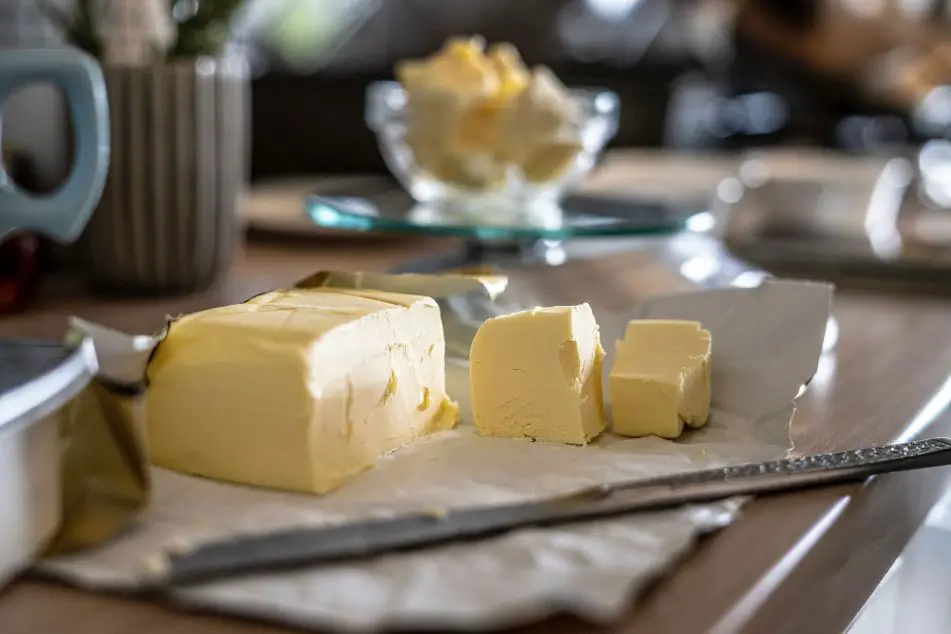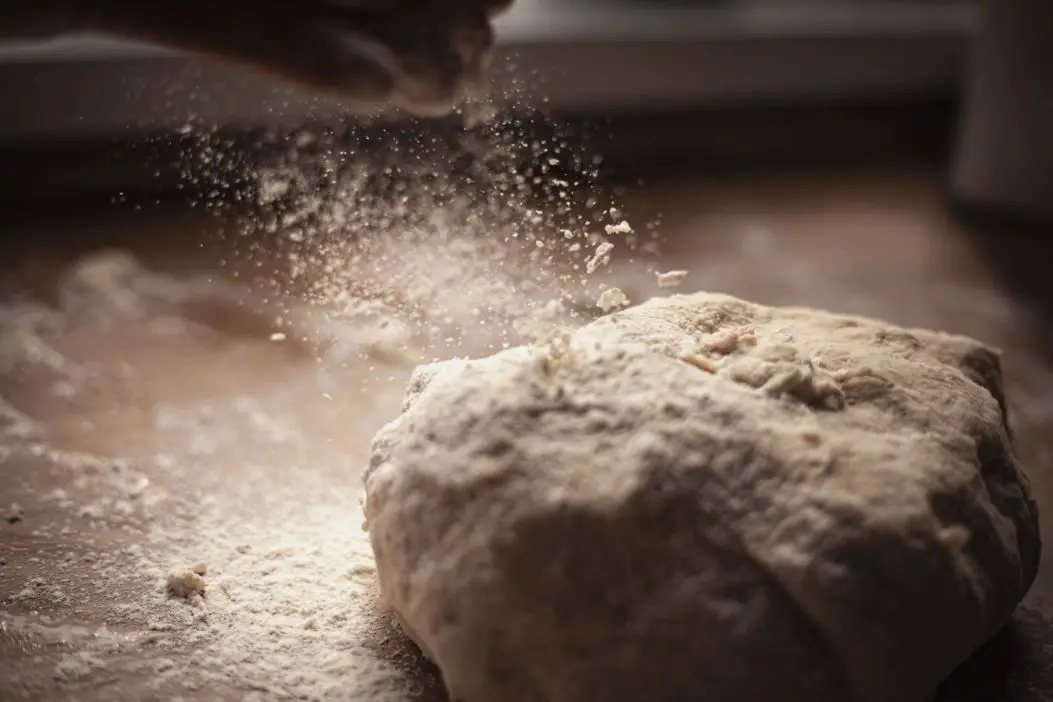Butter is a delightful addition to bread, imparting richness and flavor.
However, adding too much butter in bread dough can have unintended consequences on the final product.
Excessive butter can lead to a heavy and dense texture, hinder the dough’s rise, and alter the overall flavor.
In this article, we will explore what happens when you put too much butter in bread dough and provide 5 effective ways to fix it.
By understanding these effects and implementing the suggested fixes, you can ensure that your homemade bread turns out light, airy, and delicious.
What Happens When You Put Too Much Butter in Bread Dough
When you put too much butter in bread dough, it can have several effects on the dough and the final bread product.
Here are the 5 most common possible outcomes:
1. Heavy and Dense Texture
Excessive addition of butter to dough can result in a heavy and dense texture in the final baked product.
This is because butter, being fat, has the tendency to weigh down the dough.
When too much butter is incorporated into the dough, it interferes with the development of gluten.
Gluten is a network of proteins that forms when flour is mixed with water and kneaded.
It gives bread its structure and elasticity, allowing it to rise and create a light and airy crumb.
However, when excessive amounts of fat, such as butter, are present, they hinder the formation and development of gluten.
The presence of excess fat tightens the dough and makes it less stretchy.
As a result, the dough is unable to trap as much air during the rising process, leading to a more compact and weighty loaf of bread.
2. Poor Rise
Another consequence of adding too much butter is the hindrance of yeast activity, which is crucial for the dough to rise.
Yeast is a microorganism that ferments the carbohydrates and sugars present in the dough, producing carbon dioxide gas as a byproduct.
This gas gets trapped within the dough, causing it to expand and rise during baking.
However, the excessive butter coats the yeast cells, creating a barrier that impedes their access to the carbohydrates and sugars needed for fermentation.
As a result, the yeast’s ability to produce carbon dioxide is compromised, leading to inadequate dough rising.
The bread may turn out flatter and denser due to the limited amount of gas generated by the yeast.
3. Greasy Crumb and Crust
Butter contains both moisture and fat. When an excessive quantity of butter is incorporated into the dough, it introduces an excess of moisture.
This excessive moisture can lead to a greasy texture in both the crumb (the interior of the bread) and the crust (the outer layer).
Also, the presence of too much moisture can make the bread less appealing and affect its overall taste and mouthfeel.
4. Difficulty in Handling
Dough that contains an excess of butter tends to become sticky and greasy in nature.
This makes it challenging to handle and shape properly.

When working with the dough, it can stick to your hands, the work surface, or the baking pan, making it difficult to achieve the desired shape or structure for the bread.
This can be particularly problematic when trying to shape the dough into specific forms, such as rolls or braided loaves.
5. Alteration of Flavor
When an excessive amount of butter is added to the dough, it can overpower the other ingredients and create an excessively buttery taste.

This can significantly alter the intended flavor profile of the bread and disrupt the balance of flavors.
The overpowering effect of excessive butter can mask the subtle nuances of other ingredients in the bread.
Instead of a well-rounded flavor profile where different components complement each other, excessive butteriness can dominate and overshadow the other flavors.
As a result, the bread may lack the desired complexity and depth of taste, potentially diminishing the overall satisfaction of consuming it.
Furthermore, an excessively buttery taste can be overwhelming for individuals who prefer a more balanced or mild flavor in their bread.
It may deviate from their expectations and preferences, leading to a less enjoyable eating experience.
How to Fix Too Much Butter in Bread Dough
Bread baking is a delicate process, and even a minor error can affect the final result.
If you find out that your bread dough has too much butter, don’t worry! Here are some effective ways to help you fix it:
1. Add More Flour
When faced with the problem of excessive butter in your bread dough, there’s a helpful technique you can employ to address this issue.
Gradually adding small amounts of flour while kneading can make a significant difference.

The additional flour serves the purpose of absorbing the excess butter, which leads to a more well-balanced dough overall.
It’s crucial to incorporate the flour slowly and in small increments. This approach allows you to assess the dough’s consistency as you go, ensuring it doesn’t become overly dry.
The ultimate aim is to achieve a more manageable dough that is neither excessively sticky nor greasy.
2. Adjust Other Ingredients
If adding more flour doesn’t completely resolve the issue, another approach is to adjust the other ingredients in the recipe.
By increasing the quantities of the remaining ingredients proportionally, you can restore the overall balance of the dough.
For instance, if you accidentally doubled the amount of butter, you should also double the quantities of the other ingredients, such as flour, water, salt, and sugar.
This adjustment ensures that the dough maintains the desired texture and flavor.
However, it’s important to note that the amount of yeast should not be doubled as it can affect the dough’s rising process.
3. Allow for Extra Rising Time
When there is an excess amount of butter in the bread dough, it can hinder the rising process.
The presence of butter can weigh down the dough and impede the development of gluten, which is crucial for structure and texture.

To overcome this issue, it is essential to give the dough additional time to rise and expand in size.
This extended rising period allows the gluten strands to strengthen and stretch, resulting in a better texture.
Moreover, it provides the yeast with ample opportunity to ferment and produce carbon dioxide gas, which creates air pockets throughout the dough.
These air pockets contribute to a lighter and more airy texture in the final baked bread.
4. Chill the Dough
When excessive butter is incorporated into bread dough, it can make the dough excessively soft and sticky.
This can make it challenging to handle and shape the dough properly.
To fix this problem, it is recommended to refrigerate the dough for around 30 minutes before continuing with the recipe.
The chilling process helps solidify the butter and firm up the dough, making it easier to work with.
The cooler temperature also reduces the stickiness, allowing you to handle and shape the dough more easily.
After the dough has been chilled, you can proceed with the rising and shaping steps outlined in your recipe, knowing that the dough will be more manageable and yield better results.
5. Divide and Conquer
If you’ve adjusted the dough by adding flour but still find it excessively buttery, dividing it into smaller portions can be an effective solution.
Instead of shaping the dough into a single large loaf, consider creating individual rolls or smaller loaves.
By doing this, the excess butter will be spread out among multiple smaller pieces.
This division helps alleviate the overpowering butter flavor and has the potential to yield a more balanced texture and taste throughout the bread.
Each smaller portion will have a reduced concentration of butter, making it more enjoyable to eat.
Too Much Butter in Bread Dough – Conclusion
In conclusion, putting too much butter in bread dough can have several negative effects on the final product.
It can result in a heavy and dense texture, hinder the dough from rising properly, create a greasy crumb and crust, make the dough difficult to handle, and alter the flavor of the bread.
However, there are ways to fix the issue. Adding more flour gradually while kneading can help absorb the excess butter and achieve a more balanced dough.
Adjusting the other ingredients proportionally can also restore the overall balance.
Additionally, dividing the dough into smaller portions can help distribute the excess butter more evenly and create a more enjoyable eating experience.
With these techniques, it’s possible to fix a batch of bread dough that has too much butter and still achieve a delicious result.

